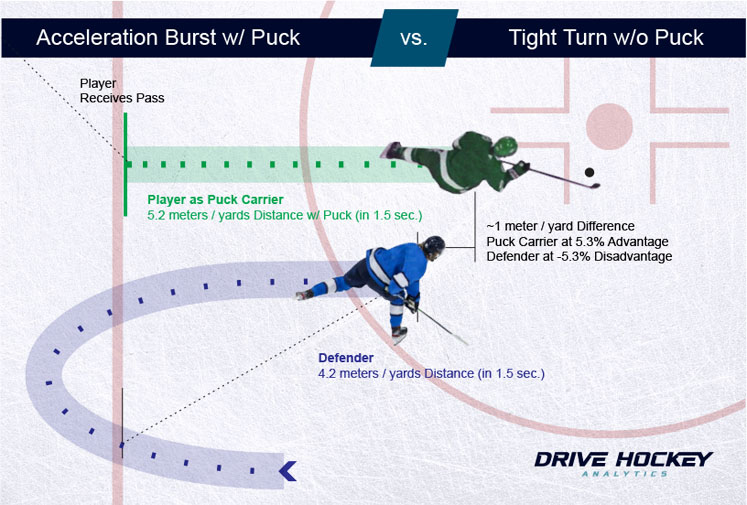Hockey is a fast-paced game of time and space, where small advantages can make a significant impact on a player’s performance. Performance tracking and analytics have become essential tools for identifying a player’s strengths and weaknesses and creating data-driven hockey training programs to improve their game.
How Performance Tracking Can Help Identify Strengths and Weaknesses
Performance tracking enables coaches and trainers to collect objective data on a player’s performance, such as their speed, acceleration, and deceleration, conditioning, puck handling, shot speed, and more. This data can then be analyzed to identify strengths and weaknesses in a player’s game; how they perform versus their peer groups or other benchmarks and what exact areas will help them improve. Sensor-based player tracking is designed to enhance on-ice combines and hockey evaluations, while supporting stronger player development programs.

In the above example, tracking how players perform a tight turn reveals how the details of the turn impacts the outcome it has on the game, in the above case a 2.5 meter / yard gain within 2.0 seconds. How fast the player is able to enter the turn, maintain their speed and exit the turn while keeping the radius tight will have a direct correlation on that players game. Tracking the data points enables coaches to identify which players are excelling in certain areas and which ones need to improve.

One critical aspect of player tracking is the ability to tie on-ice performance with off-ice training. For instance, a player’s ability to accelerate quickly can make all the difference in closing gaps and winning matchups. By analyzing acceleration data, coaches and players can identify areas for improvement and focus their training accordingly. If a player requires on-ice work on acceleration skating technique, or whether they need off-ice leg strength training to handle the load a player is physically able to accelerate – smaller players need less acceleration force to reach higher speeds.
The Benefits of Data-Driven Hockey Training
Data-driven hockey training allows coaches to create personalized training programs based on a player’s specific needs. By identifying a player’s strengths and weaknesses through performance tracking, coaches can create targeted drills to improve the areas where a player needs the most work. For example, if a player struggles with acceleration, coaches can design drills to help them improve their acceleration technique and off-ice trainers can work on building explosive leg strength.
Data-driven training also helps players understand their progress and set realistic goals. By tracking their performance over time, players can see their improvement and adjust their training accordingly. This data can also be used to motivate players, as they can see how their hard work is paying off.
Examples of Performance Tracking and Analytics in Hockey Training
One of the primary advantages of using performance tracking and analytics in hockey training is the ability to measure specific skills and attributes that contribute to a player’s overall performance. Here are some examples of how performance tracking can be used to analyze and improve a player’s skills:
Tracking Skating Speed and Agility
One of the most critical skills in hockey is speed and agility on the ice. Performance tracking technology allows coaches to measure and analyze a player’s speed and agility, including acceleration and deceleration, turning speed, and overall skating efficiency across a variety of metrics. Using player tracking technologies coaches can understand what a player is capable of in different scenarios, versus how they actually perform in game situations.

Player vs. Opponent Situational Advantages
Using player tracking data, coaches can quantify how a player performs in different situations, such as both with and without the puck. In games, these skills can be matched against each other to identify where players are at an advantage or disadvantage. In the example above, a player receives a pass and accelerates out of their zone while a opponent does a tight turn in pursuit. Understanding the players ability to accelerate with the puck versus a benchmark players ability to defend will quantify whether a player has an advantage or disadvantage in certain situations based on their abilities. By analyzing data on these kinds of situations, coaches and players can identify which player is better suited for a given role or matchup and which skills need to be developed further for the greatest impact.
Measuring Physical and Mental Fatigue
Hockey is also very demanding, requiring both physical and mental stamina. Performance tracking technology can measure a player’s physical and mental fatigue levels during a game or practice session. Through monitoring these metrics, coaches can adjust training routines to help players maintain their energy levels and avoid injury. They can identify the conditioning levels of their players, optimal shift lengths and recovery times. This can help adjust practice schedules, alter workout routines, and even adjust game strategies to accommodate player conditioning levels.
How to Implement Performance Tracking and Analytics in Your Hockey Training
Implementing performance tracking and analytics in your hockey training can seem overwhelming, but it doesn’t have to be. By following a few simple steps, you can start reaping the benefits of data-driven training.
Choosing the Right Tracking Technology and Tools
The first step in implementing performance tracking and analytics is choosing the right tracking technology and tools. One of the best technologies on the market is player location tracking. This technology allows for precise tracking of each player on the ice and provides detailed insights into their movements and performance. Drive Hockey’s player tracking sensors are designed to make this process simple and easy for amateur hockey. The sensors attach to a player’s shoulder pads and track their movements in real-time, providing coaches and players with valuable data to analyze and improve performance. Reports are generated based on AI models built specifically for hockey, providing coaches with advanced training analytics in a simple to understand manner.
Setting Clear Goals and Objectives for Training
Once you have the right technology and tools in place, set clear goals and objectives for training by defining what you want to achieve. You can focus on collecting and analyzing the data that will help you reach those goals. For example, if you want to improve a player’s performers as a defender, you can reference your defence players within Drive Hockey’s platform and see exactly what skills they are lagging behind, and where improvements will have the biggest impact on performance. Continue to track progress over time and help the players become aware of exactly what they to do to become a higher performing athlete.
Using Data to Make Informed Decisions and Improve Performance
Finally, it’s crucial to use the data you collect to make informed decisions and improve performance. By analyzing the data, you can identify strengths and weaknesses, adjust training programs, and provide targeted feedback to individual players, helping them to become aware of exactly what they need to do to improve their performance.
In conclusion, performance tracking and analytics can revolutionize your hockey training by providing valuable insights into player performance and helping you make informed decisions. By choosing the right tracking technology and tools, setting clear goals and objectives, and using data to improve performance, you can take your game to the next level. With Drive Hockey’s player tracking sensors, implementing hockey training performance tracking has never been easier!